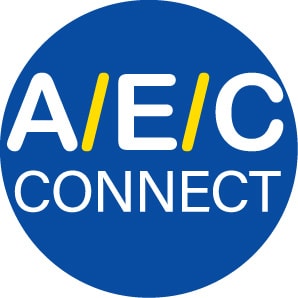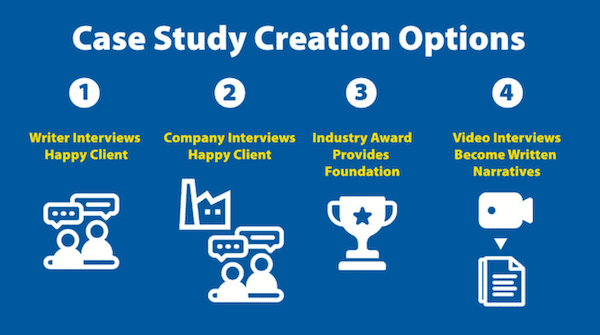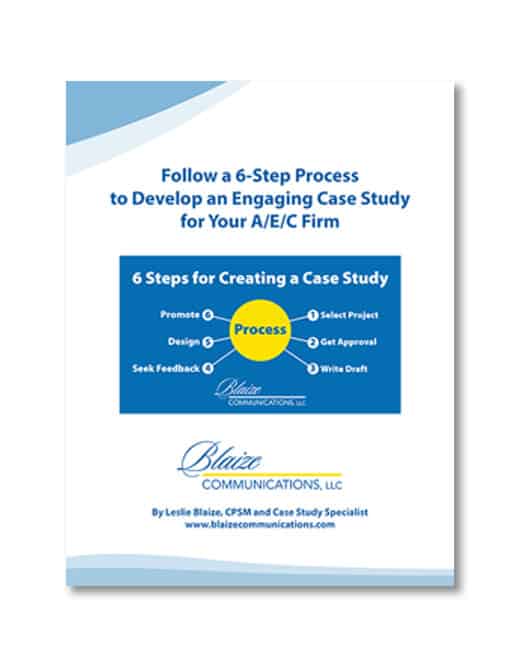I value client-focused case studies because they’re so flexible. You can use the entire document or repurpose its elements into other forms. And here’s another advantage: There are many ways to develop the document for your strategic Architecture/Engineering/Construction project.
Check out the following case study creation options. Which one would work best to promote your strategic project?
Option 1: Writer Creates the Case Study
A company, probably with input from marketers and business developers, decides on a strategic project to highlight. The happy client agrees, and then a writer interviews this individual. The writer may be on staff, or a firm may hire an external writer to create the case study.
The writer drafts questions in advance that get approved by the company. These questions then are shared with the client contact. The writer conducts the interview with the happy client and creates a draft. First, it’s reviewed by the company, and then it’s approved by the happy client.
The case study then is ready for posting on the website, or business developers could share it with prospects. Elements, such as quotes and graphics, are saved for other uses. The case study also may be repurposed as a blog, or key points can be included in social media posts.
As a writer, I prefer this approach because it’s the most direct. Writers can easily ask follow-up questions during the interview and set the stage to contact the client in the future to obtain more information.
Writers also tend to be more impartial. They probably weren’t involved in the project delivery and can remain neutral if the client offers some criticism. A client can be pleased with a project, but some parts of the process may have been challenging.
However, there are other ways to create case studies than direct writer involvement. Different approaches may work better for specific organizations.
Option 2: Company Representative Interviews the Happy Client
Some marketers may interview happy clients and then share that information with internal or external writers who will write the case study. This method may be the best if marketers want to build a relationship with the client without bringing in another party.
Marketers can collaborate with writers to develop interview questions. During the interview, the marketers should look for comments that address a project’s challenge, solution, and results. Marketers should also be encouraged to ask follow-up questions and seek examples demonstrating how an A/E/C firm went above and beyond to provide a successful project outcome.
I’ve written narratives from transcripts provided by another. If the interviewer is good, creating an engaging success story is possible.
With the submitted transcript, the writer doesn’t spend time interviewing the happy client. However, the writer must still analyze the transcript to determine the most significant content. Then the writer will identify critical elements and create an engaging story highlighting how a company worked with the client to solve a problem.
This approach may be used by marketers or business owners who don’t have the time or inclination to create a case study.
Option 3: Repurpose Industry Awards
Industry award entries provide a great starting point for creating a client-focused case study. They typically include information about a project’s challenge, solution, and results. The happy client may have written a letter in support of the client and firm. Firms may have obtained professional project photos and developed engaging graphics to clarify a project’s strategic features.
Industry awards submissions probably include the same elements needed for a client-focused success story. A writer may need to interview a happy client to get more content, but they’re starting with lots of information. The existing award submission could be expanded to add more of the human element. Key technical details could be listed in a sidebar.
Award information is often saved and reused for future proposals and client interviews. A case study could be one more way to repurpose content about a strategic project.
Option 4: Turn Client Videos Into a Case Study
Do you create client video testimonials about your A/E/C firm? These videos could be transformed into client-focused case studies. In the video, a happy client may share their challenges and how a firm helped them provide a solution and results.
If there’s enough information, a writer could create an engaging case study without another interview. The case study could incorporate key quotes from the video interview, and additional project information could be provided in a sidebar.
Ideally, an A/E/C firm would ask the client if the video could be transformed into a case study. The client could review the narrative before it’s posted.
An organization then could provide a link from the video to the case study and vice versa.
I wrote a case study for Kyle Wege of Crimson Sun Studios, Madison, Wisconsin, based on his interviews with Scott Truehl, executive vice president of Friede & Associates. The case study highlighted Wege’s architectural photography used for a winning award entry.
I quoted Truehl in the written case study using snippets from his video interviews. They emphasized the value of Wege’s photography.
Case Study Creation Options
Client-focused case studies can amplify your marketing efforts and engage stakeholders. To create this narrative, you can follow the standard approach of having a writer interview your happy client. Or it may make more sense to build upon an industry award entry or repurpose a client video interview.
If you’re spending time promoting one of your firm’s key projects, take a moment to consider the creation of a client-focused case study as part of the process. It’s one more way to improve the return on investment for your efforts.
Want to Know More?
Are you considering a case study for your firm? Feel free to reach out to discuss the best approach at blaizecommunications@gmail.com.I’m also available to speak or present on developing impactful case studies or understanding the benefits and pitfalls of using Artificial Intelligence for content creation.



